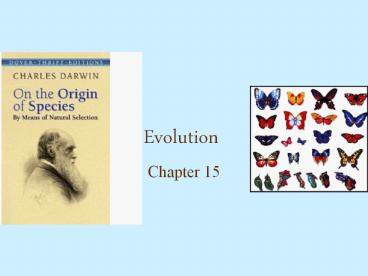Evolution - PowerPoint PPT Presentation
Title: Evolution
1
Evolution
- Chapter 15
2
What is Evolution?
- States that characteristics of plants and animals
change over time - The changes give them some type of advantage
3
Charles Darwin English Scientist (1809-1882)
- Naturalist on the HMS Beagle for 5 years
- Found populations on the Galapagos Islands that
were similar to mainland populations but had
unique characteristics perfect for island life - Finches beak type / body shape
- Tortoise shells
4
(No Transcript)
5
(No Transcript)
6
What is Natural Selection?
- Natural selection is the mechanism for evolution
- Certain adaptations are selected FOR or AGAINST
and over time adaptations that convey an
advantage are found in the majority of the
population
7
From where do adaptations come?
- They are caused by random gene mutations which
can be good, bad, or do nothing - Good become more frequent
- Bad become less frequent
8
Natural Selection
- 1. In a population, individuals have variation
- 2. Individuals with certain useful variations are
more likely to survive and reproduce - 3. Over time, offspring with those certain useful
variations make up most of the population
9
Natural Selection Fundamentals
- Over-production - produce more offspring than
will survive - Variation - Genetic
- Competition - Compete for limited resources
- Survival - Offspring with the most favorable
traits survive and reproduce
10
Patterns of Selection that emerge in evolution
- Stabilizing favors average individuals
- Directional favors one extreme or the other
- Disruptive favors both extremes
11
Stabilizing Selection
- Average individuals have a selective advantage
- Reduces variation in a population
- Happens in stable environments
12
(No Transcript)
13
(No Transcript)
14
(No Transcript)
15
Directional Selection
- Favors one of the extreme variations of a trait
- Can lead to rapid evolution of a population
16
(No Transcript)
17
(No Transcript)
18
(No Transcript)
19
Disruptive Selection
- 1. Favors both extreme variations of a trait
- 2. Leads to evolution of two new species
20
(No Transcript)
21
(No Transcript)
22
(No Transcript)
23
Two general ideas were proposed
- Lamarck said organisms can Acquire adaptations
during their lifetime and pass them on to their
children this is WRONG! - Individuals do not evolve!
- Darwin said variation exists in any population
and certain traits give an advantage. Those
organisms with the traits produce more offspring
and the traits slowly increase in frequency in a
population! - Populations evolve!
24
Evolution 2 different ideas
- LaMarck (1809)
- 2. Darwin
- (1859)
25
What evidence exists for evolution?
- Structural adaptations
- Physiological/metabolic adaptations
- Fossil record
- Anatomy
- Embryology
- DNA/RNA/Protein sequence comparisons
26
Structural Adaptations
- - Physical adaptations that increase an
organisms survival - Examples
- Mimicry trying to look more dangerous
- Camouflage trying to blend in and hide
27
2. Physiological/metabolic adaptations
- Changes in an organisms metabolic processes
- Examples
- Insect and weed resistance to pesticides/herbicide
s - Antibiotic resistance in bacteria
28
3. Fossil Record
- Provide a record of early life and evolutionary
history - Examples
- Whales were once land mammals
- Horse evolution
29
Whale evolution
30
4. Anatomy
- Looking at the structural and functional
similarity of a body feature - Examples are homologous structures
- common bone structure found in all mammals
indicate a common ancestor
31
Anatomy cont.
- analogous structures are similar in function but
not from a common ancestor like wings
- Vestigial structures do not have current function
but were useful to an ancestor like appendix
32
5. Embryology
- Similarities of young embryos suggest evolution
from a distant, common ancestor - Examples
- Fish, reptile, bird, and mammal embryo
33
6. Biochemistry (molecular)
- Comparing DNA, RNA, and amino acids and looking
for sequence similarities (more changes more
distantly related) - Examples
- Cytochrome C
- Hemoglobin
34
What is a gene pool?
- All of a populations alleles and their frequency
- R 75
- r 25
35
What is genetic equilibrium?
- When the frequency of alleles in the gene pool is
not changing. - No evolution or natural selection taking place.
- Year 1900 60 H and 40 h
- Year 2000 60 H and 40 h
36
What is genetic drift?
- Genetic Drift is a change in the gene pool due to
random sampling (by chance and unavoidable) - Greatly affects small population
37
What is the founder effect?
- Loss of genetic variation when a new population
is founded with a small number of individuals
(thus a same gene pool)
38
What is Gene Flow?
- Gene flow is the transfer of genes from one
population to another usually by migration into
and out of a population
39
What is Speciation?
- Speciation the process in which new species
evolve from a common ancestor - Species a group of organisms that interbreed
and produce fertile offspring
40
How does Speciation Happen?
- Three main ways species evolve
- Geographic Isolation
- 2. Reproductive Isolation
- 3. Change in number of chromosomes polyploidy
41
Divergent Evolution
- When species that were once similar become more
and more different. - Adaptive Radiation
- one species evolves into an array of different
species to fit environmental habitats
42
2. Convergent Evolution
- When species that were unrelated evolve similar
characteristics
43
Gradualism vs. Punctuated Equilibrium
- Gradualism species originates by gradual rate of
time - Stable environment
- Punctuated Equilibrium speciation in short rapid
bursts - Catatrophic events that leave niches open
- Dinosaur extinction mammals
44
(No Transcript)































